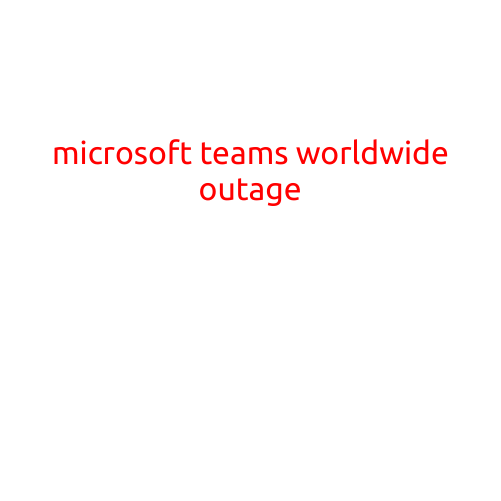
Microsoft Teams Experiences Worldwide Outage, Disrupting Communication for Thousands
Microsoft Teams, a popular communication platform used by businesses and individuals worldwide, experienced a major outage on [Date] that left thousands of users unable to access the service.
The outage, which was reported by users and monitored by outage tracking websites, began around [Time] and lasted for several hours, disrupting communication and collaboration for teams and organizations across the globe.
Microsoft Teams allows users to communicate through chat, video meetings, and file sharing, making it a critical tool for many businesses and professionals. However, the outage caused widespread frustration and inconvenience for those who rely on the platform to stay connected and productive.
“We are experiencing issues with Microsoft Teams, including the inability to access the platform and issues with video meetings,” Microsoft acknowledged in a statement. “Our team is working to resolve the issue as quickly as possible and apologize for the disruption caused by the outage.”
The cause of the outage was not immediately clear, but Microsoft did not provide any information on the root cause of the problem. The company typically takes stock of its services and infrastructure regularly to ensure high uptime and performance, but sometimes outages can still occur due to various reasons, including network congestion, server issues, and maintenance.
As the outage continued, users took to social media to express their frustration and disappointment. “Just when I need to attend a meeting, @MicrosoftTeams decides to go dark,” tweeted one user. “So frustrating!” wrote another.
Microsoft Teams is widely used by businesses, non-profit organizations, and educational institutions, and the outage had a significant impact on these organizations. For example, a large company in the tech industry reported that they were unable to access the platform, which disrupted their internal communication and collaboration.
The outage served as a reminder of the importance of having redundant systems and backup plans in place to minimize the impact of technology failures. While Microsoft has a reputation for providing reliable services, the outage highlighted the potential risks and vulnerabilities that can arise from relying on a single platform.
In the meantime, Microsoft has restored service to most users, and the company is working to prevent similar outages from occurring in the future. As the global dependence on digital communication continues to grow, it is essential that service providers like Microsoft prioritize system redundancy and backup plans to ensure that disruptions are minimized.
Timeline of the Outage:
- [Time]: Users begin reporting issues with Microsoft Teams, including the inability to access the platform and issues with video meetings.
- [Time]: Microsoft acknowledges the outage and apologizes for the disruption.
- [Time]: Microsoft reports that they are working to resolve the issue as quickly as possible.
- [Time]: The outage continues, with users taking to social media to express their frustration and disappointment.
- [Time]: Microsoft reports that most users have been restored to service, and the company is working to prevent similar outages from occurring in the future.
Impact:
- Thousands of users were affected by the outage, which disrupted communication and collaboration for businesses and individuals worldwide.
- The outage highlighted the importance of having redundant systems and backup plans in place to minimize the impact of technology failures.
- Microsoft’s reputation for providing reliable services was temporarily impacted by the outage.
What’s Next:
- Microsoft is working to prevent similar outages from occurring in the future by strengthening its system redundancy and backup plans.
- The company is also conducting an internal investigation to determine the root cause of the outage and implement corrective measures.
- Users are advised to maintain a backup plan for their digital communication needs to ensure minimal disruption in the event of future outages.





